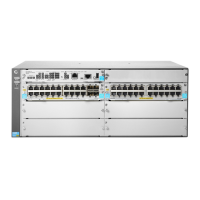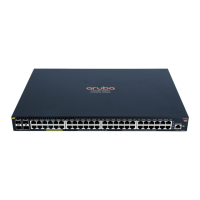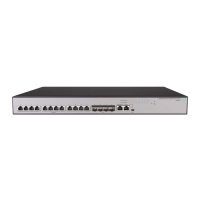8
Depending on your configuration, when a particular type of traffic exceeds its upper threshold, the
interface does either of the following:
• Blocks this type of traffic, while forwarding other types of traffic—Even though the
interface does not forward the blocked traffic, it still counts the traffic. When the blocked traffic
drops below the lower threshold, the port begins to forward the traffic.
• Goes down automatically—The interface goes down automatically and stops forwarding any
traffic. When the blocked traffic is detected dropping below the lower threshold, the port does
not forward the traffic. To bring up the interface, use the undo shutdown command or disable
the storm control feature.
Any of the storm-constrain, broadcast-suppression, multicast-suppression, and
unicast-suppression commands can suppress storm on a port. The broadcast-suppression,
multicast-suppression, and unicast-suppression commands suppress traffic in hardware, and
have less impact on device performance than the storm-constrain command, which performs
suppression in software.
Storm control uses a complete polling cycle to collect traffic data, and analyzes the data in the next
cycle. An interface takes one to two polling intervals to take a storm control action.
Configuration guidelines
For the same type of traffic, do not configure the storm constrain command together with any of the
broadcast-suppression, multicast-suppression, and unicast-suppression commands.
Otherwise, the traffic suppression result is not determined. For more information about the
broadcast-suppression, multicast-suppression, and unicast-suppression commands, see
"Configuring storm suppression."
Configuration procedure
To configure storm control on an Ethernet interface:
Step Command Remarks
1. Enter system view.
system-view
N/A
2. (Optional.) Set the traffic
polling interval of the storm
control module.
storm-constrain interval
seconds
The default setting is 10 seconds.
For network stability, use the
default or set a higher traffic
polling interval (10 seconds).
3. Enter Ethernet interface
view.
interface
interface-type
interface-number
N/A
4. (Optional.) Enable storm
control, and set the lower
and upper thresholds for
broadcast, multicast, or
unknown unicast traffic.
storm-constrain
{
broadcast |
known-unicast
|
multicast
|
unicast
}
{
pps
|
kbps
|
ratio
}
max-pps-values min-pps-values
By default, storm control is
disabled.
The
known-unicast
key word is
available in Release 1121 and
later.
5. Set the control action to take
when monitored traffic
exceeds the upper
threshold.
storm-constrain control
{
block
|
shutdown
}
By default, storm control is
disabled.
6. (Optional.) Enable the
interface to log storm control
threshold events.
storm-constrain enable log
By default, the interface outputs
log messages when monitored
traffic exceeds the upper
threshold or falls below the lower
threshold from the upper
threshold.
7. (Optional.) Enable the
interface to send storm
control threshold event
traps.
storm-constrain enable trap
By default, the interface sends
traps when monitored traffic
exceeds the upper threshold or
drops below the lower threshold

